Michigan hop scouting report for July 10, 2015
Japanese beetles have arrived in southern and central Michigan, and potato leafhopper populations are building.

Northwest summary
Hop bines are at the top wire and various stages of burr formation in central and northwest Michigan. Downy mildew continues to be a challenge for many growers, rose chafer populations are down dramatically and mite populations are relatively moderate. Beneficial mites, including Phytoseiid species, are present in many hopyards. Potato leafhopper numbers remain substantial with damage becoming visible at many locations. Japanese beetles have emerged in central Michigan. Growers are wrapping up major nitrogen applications for the season as cone development is underway. For more information on hop fertility and nutrient needs, please visit the Resources page on Michigan State University Extension’s Growing Hops website.
Southwest summary
Vertical growth of bines has stopped, and hop plants are developing lateral shoots. At this point in the season, hop plants have taken up most of the nitrogen (N) they are capable of using, so growers should slow down or stop fertilization with N. For more information on hop fertility and nutrient needs, please visit the Resources page on MSU Extension’s Growing Hops website.
Pressure from downy mildew is developing, though it appears to be lower in the southwest compared to other regions of the state. Where fungicide coverage was not consistent ahead of wet periods in June, downy mildew is now developing in earnest. Beneficial insects are becoming prevalent, lady beetles are currently active, lacewings are hatching from eggs and feeding on herbivorous insects, and many other natural predators are present. At this time, potato leafhopper and twospotted spider mite damage has been observed in the field, so growers should be alert to both of these pests and scout before damage occurs. Aphids have also begun to appear in hopyards, but so far in low numbers. In some low-lying areas, night feeding from caterpillar pests has been observed on leaves. Japanese beetle are emerging.
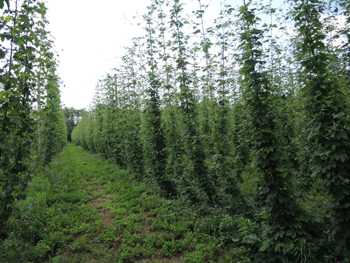
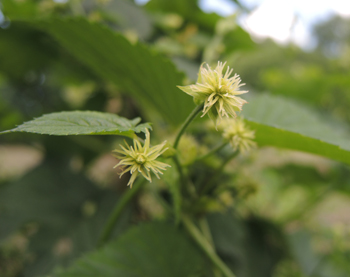
‘Cascade’ at the top wire and with burrs present in west central Michigan, July 9, 2015.
Statewide report
Growing degree day (GDD) accumulation and rainfall summary | |||
|---|---|---|---|
|
Location |
GDD45 |
GDD50 |
Rain (inches) |
|
Traverse City |
1,214 |
854 |
0.41 |
|
Clarksville |
1,401 |
1,007 |
0 |
|
Romeo |
1,529 |
1,117 |
0.35 |
|
Benton Harbor |
1,592 |
1,180 |
0.5 |
Growers should be scouting for twospotted spider mites at this time. Moderate temperature and rainfall have kept populations moderate at most locations. Twospotted spider mites are a significant pest of Michigan hops and can cause complete economic crop loss when high numbers occur. Twospotted spider mites decrease the photosynthetic ability of leaves, cause direct mechanical damage to hop cones and act as a contaminate pest in harvested cones. Twospotted spider mites feed on the liquid in plant cells, eventually causing visible symptoms. Leaves take on a white appearance and will eventually defoliate under high pressure conditions. Intense infestations weaken the plant and reduce yield and quality. Infested cones develop a reddish discoloration, do not hold up to the drying process and commonly have lower alpha levels and shorter storage potential.
In the spring, only female twospotted spider mites are present. After they mate, females overwinter in a dormant stage on debris and trellis structures. They emerge in the spring already mated and ready to lay fertilized eggs. As the temperature warms, the females feed and begin laying eggs. Larvae emerge from the eggs in two to five days, depending on temperature, and develop into adults in one to three weeks, again depending on temperature. Twospotted spider mites like it hot with the pace of development increasing until an upper threshold around 100 degrees Fahrenheit is reached. Conversely, cold and wet weather slows down their development.
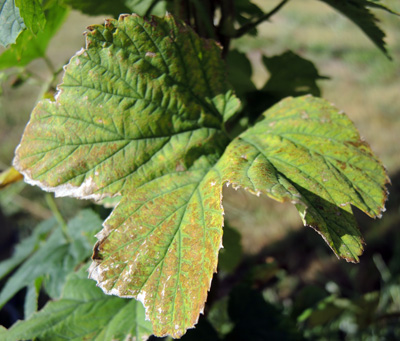
Damage to hop leaves caused by twospotted spider mite feeding.
Twospotted spider mites are very small but can be observed on the underside of leaves using a hand lens. As the season progresses, cast skins and old webbing give infested leaves a dusty and dirty appearance. The eggs look like tiny, clear spheres and are most commonly found in close proximity to adults and larvae. The larvae themselves are small, translucent versions of the adults which begin the season with a distinctly orange hue that changes over to translucent, yellow or green as they feed. Adults also have two distinctive dark spots, hence the name.
When observing the underside of leaves, keep an eye out for beneficial predatory mites that actually feed on twospotted spider mites. Predatory mites are often translucent, larger than twospotted spider mites and move at a much faster speed across the leaf surface. Predatory mites play an important role in balancing the twospotted spider mite population and should be protected when possible by avoiding the use of broad spectrum insecticides. Refer to pages 11-12 of “Pesticides registered for use on hop in Michigan 2015” for more information about impacts of pesticides on beneficial mites.
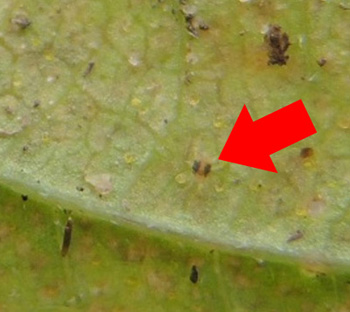
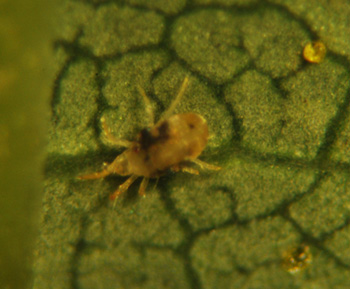
Twospotted spider mites as seen with the naked eye and under magnification. Note the sand and cast skins collecting on the webbing associated with the mites, giving the leaves a dusty appearance.
Growers should also continue to evaluate the prevalence of potato leafhoppers in hopyards. Storm systems that moved through during spring carried adults from the Gulf Region. Populations around the state have increased substantially over the past weeks and leaf damage is visible. Potato leafhoppers move in all directions when disturbed, unlike some leafhoppers that have a distinct pattern of movement. Adults and nymphs appear a fluorescent green color. Some very small nymphs are actually clear but have the characteristic shape of the larger nymphs when viewed using a hand lens.
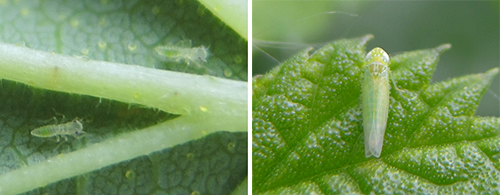
Potato leafhopper wingless nymphs (left) and adult (right) on hop.
Although hop plants are susceptible to potato leafhoppers, they can tolerate some level of feeding and growers should be conservative in the application of insecticides. Potato leafhoppers cause what growers have termed “hopper burn,” which causes necrosis of the leaf margin in a v-shaped pattern and may cause a yellowed or stunted appearance as well. When hops bines are shaken quickly, adults will take flight. Growers can go through and shake bines and look for flying adults as a quick spot-check. Confirm their presence by flipping leaves over and looking for adults and wingless nymphs on the undersides.
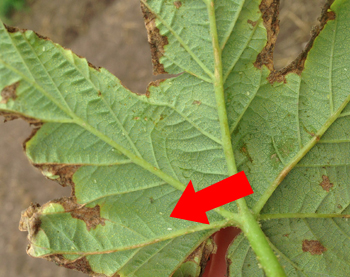
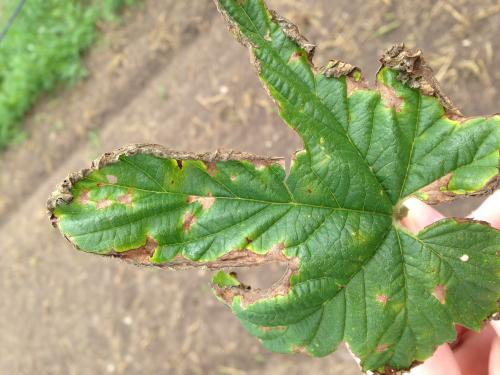
Multiple potato leafhopper nymphs and adults on the underside of a hop leaf exhibiting necrotic “hopper burn” symptoms around the leaf margin.
Growers needing to treat for potato leafhoppers can utilize labeled products containing neonicitinoids (IRAC group 4A, e.g., thiamethoxam and imidacloprid), pyrethroids (group 3A, e.g., beta-cyfluthrin, bifenthrin and pyrethrin), organophosphates (group 1B, e.g., malathion), tetramic acid derivatives (group 23, e.g., spirotetramat) or spinosyns (group 5, e.g., spinosad). Organic growers can utilize spinosad or pyrethrin formulations that are OMRI-approved for potato leafhopper management. For a complete list of registered products and the chemical class to which they belong, refer to “Pesticides registered for use on hop in Michigan 2015.” Refer to pages 11 and 12 to determine which products will have the least negative impact on important beneficial insects like predatory mites.
Japanese beetles are beginning to emerge around the state. Japanese beetle adults are considered a generalist pest that affect many crops found on or near grassy areas, particularly irrigated turf. Japanese beetle grubs feed on grass roots in early spring and again in the fall and can cause significant damage to turf. They prefer moist soil conditions and do not survive prolonged periods of drought.
Adult Japanese beetles emerge in early July and feed on hundreds of different plant species. Adult beetles feed on the top surface of leaves, skeletonizing the tissue. If populations are high, they can remove all of the green leaf material from between the veins on entire plants.
Japanese beetle adults are a substantial insect and measure 0.375-0.5 inches long. The thorax is green and wing covers are copper-colored. There are five tufts of white hairs on both sides of the abdomen and a pair of tufts on the end of the abdomen that can help distinguish Japanese beetles from other look-alike species. The legs are black.
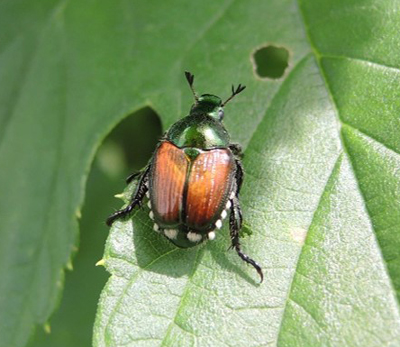
Japanese beetle adult, note the white tufts along the abdomen and emerald thorax.
Visual observation of adults or feeding damage is an effective scouting technique. Growers should scout along a transect through hopyards at least weekly until detection. Because of their aggregating behavior, they tend to be found in larger groups and are relatively easy to spot. Pheromone and floral baited traps are available and can help indicate the arrival of adults and estimate the potential pest pressure, but are not considered effective for trapping out Japanese beetles. Growers considering the traps should remember they may attract Japanese beetle adults from the surrounding area and contribute to damage. There are no established treatment thresholds or data on how much Japanese beetle damage hops can sustain. Well-established and vigorous bines will likely not require 100 percent protection, but younger bines with limited leaf area will need to be managed more aggressively. Also, if flowers burrs are present and being fed on heavily, growers should consider management.
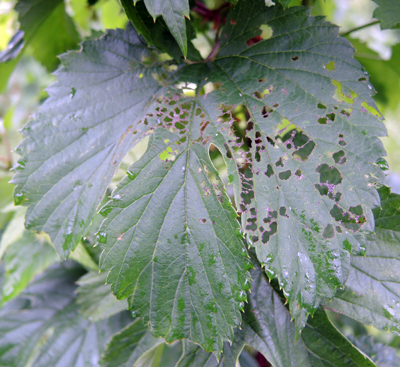
Japanese beetle feeding damage on hop leaves leaving a lace like appearance.
Managing Japanese beetles can be a frustrating endeavor as they often re-infest from surrounding areas, especially during peak adult emergence in July. This re-infestation is often misinterpreted as an insecticide failure, but efficacy trials have shown that a number of insecticides remain effective treatment options. Malathion is effective, but can take up to three days to take effect and provides 10-14 days of residual control. Pyrethroids (bifenthrin or beta-cyfluthrin) have good knockdown activity and seven to 10 days of residual control, but can be problematic in hopyards where mites are a concern. Pyrethroid use has been shown to flare spider mite populations, killing predatory mites which help keep pest mite populations in check. Neonicitonoids (imidacloprid or thiamethoxam) have contact toxicity for two to five days, and then a longer residual period of plant protection during which they act as an anti-feedant. OMRI-approved organic options include neem-based products (azadirachtin), which have a one to two day residual and good knockdown activity as well as Surround (kaolin clay), which has had good results in blueberries and grapes and acts as a physical barrier and irritant. For a complete list of registered, see “Pesticides registered for use on hops in Michigan.” Consider the impact of applications on beneficial insects and always read the label.
Downy mildew management should still be happening. Wet and humid conditions last fall and this spring have provided ideal conditions for downy mildew to become a problem in Michigan hopyards. All hopyards, even new yards not exhibiting signs or symptoms of downy mildew, should be utilizing a protectant fungicide program season-long (from 6-inch bines through harvest) to minimize downy mildew infection. Even when growers follow best management practices, downy mildew can be a problem. The severity of downy mildew is increased by high disease pressure from previous outbreaks, conducive environmental conditions, poor fungicide timing, suboptimal spray coverage, fungicide wash-off, cultivar susceptibility or a combination of factors.
In addition, fungicide resistance may play a role in some cases. Growers who were able to apply fungicide treatments on a protectant basis ahead of recent rain events are seeing lower infection levels, but still experiencing significant pressure for this time of the season. For more information about downy mildew biology and management, refer to “Management options for hopyards with downy mildew.” Also note that a new product called Presidio is now available for use in Michigan. For more information, read “New downy mildew fungicide available for Michigan hop growers.”
Damson hop aphids (Phorodon humuli) have been spotted in southwest Michigan in low numbers and are one of the primary pest species in hop production in the northern hemisphere and can cause major damage and economic losses. In Michigan, we tend to see aphids in the field on baby hop plants. They are easily controlled early in the season and rarely require follow-up treatments. Aphids generally thrive under greenhouse conditions and can be moved to new locations via nursery stock. Growers should be managing to prevent plant and cone damage.
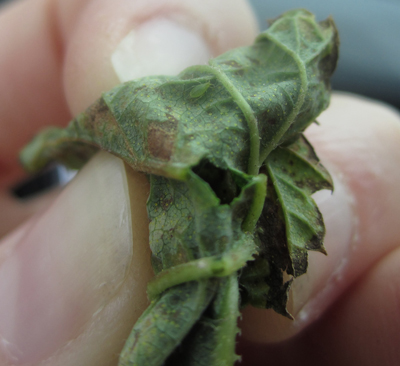
A wingless Damson aphid on hop.
The following information regarding Damson hop aphids is summarized from the publication, “Field Guide for Integrated Pest Management in Hops.”
Damson hop aphids are small (0.05-0.1 inches), pear-shaped and soft-bodied insects that may either be winged or wingless. Wingless aphids are pale white to green and are typically found on the underside of leaves. Winged aphids are dark green or brown with black markings on the head and abdomen. Aphids have two cornicles or “tailpipes” at the end of the abdomen.
Aphids remove nutrients and moisture from leaf and cone tissue with their piercing and sucking mouthparts. Damaged leaves may curl and wilt; heavy infestations can cause defoliation. Cone feeding can cause wilt-like symptoms in the cones and browning. When feeding, aphids secret sugary honey dew that can support the growth of secondary fungi and bacteria, most notably sooty mold. Sooty mold reduces photosynthesis and can make cones unsaleable. Aphids can also transmit viruses.
Damson hop aphids overwinter as eggs on Prunus species, a genus of trees and shrubs including plums, cherries, peaches, nectarines, apricots and almonds. These species are prevalent in agricultural settings and the landscape in Michigan. In early spring, eggs hatch into stem mothers which give birth to wingless females that feed on the Prunus host. In May, winged females are produced and travel to hop plants where additional generations of wingless females are produced. As many as 10 generations may occur in a season with each female producing 30-50 offspring in her lifetime. Aphids do not reproduce as quickly in hot and dry weather, preferring more moderate temperatures and moisture levels. As cold weather approaches, winged females and males are produced and move back onto a Prunus host, where they mate and lay eggs before winter. We expect this migration off of hops and onto plants in the Prunus genus will occur sometime in September in Michigan.
Monitoring for aphids should begin when daytime temperatures exceed 58-60 F and continue through harvest. Aphids are not tolerated after flowering because cone infestations are very difficult to treat. Growers experiencing aphid infestations should consider that excessive nitrogen application and large flushes of new growth favor outbreaks. Ideally, growers would apply early season controls to limit population growth over the season. For a complete list of registered products for the control of aphids, refer to “Pesticides registered for use on hops in Michigan.” Consider the impact on beneficial insects before selecting a pesticide and always read the label.
Question mark (Polygonia comma) butterfly caterpillars are making an appearance in Michigan yards. This pest is typically not overly abundant and is a simple foliar feeder that will likely not require management on established vigorous hop plants.
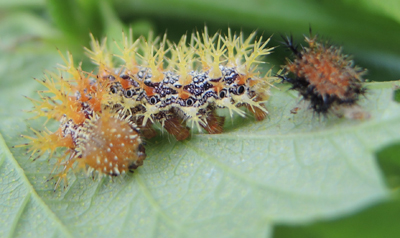
Question mark caterpillar feeding on hop.



 Print
Print Email
Email

